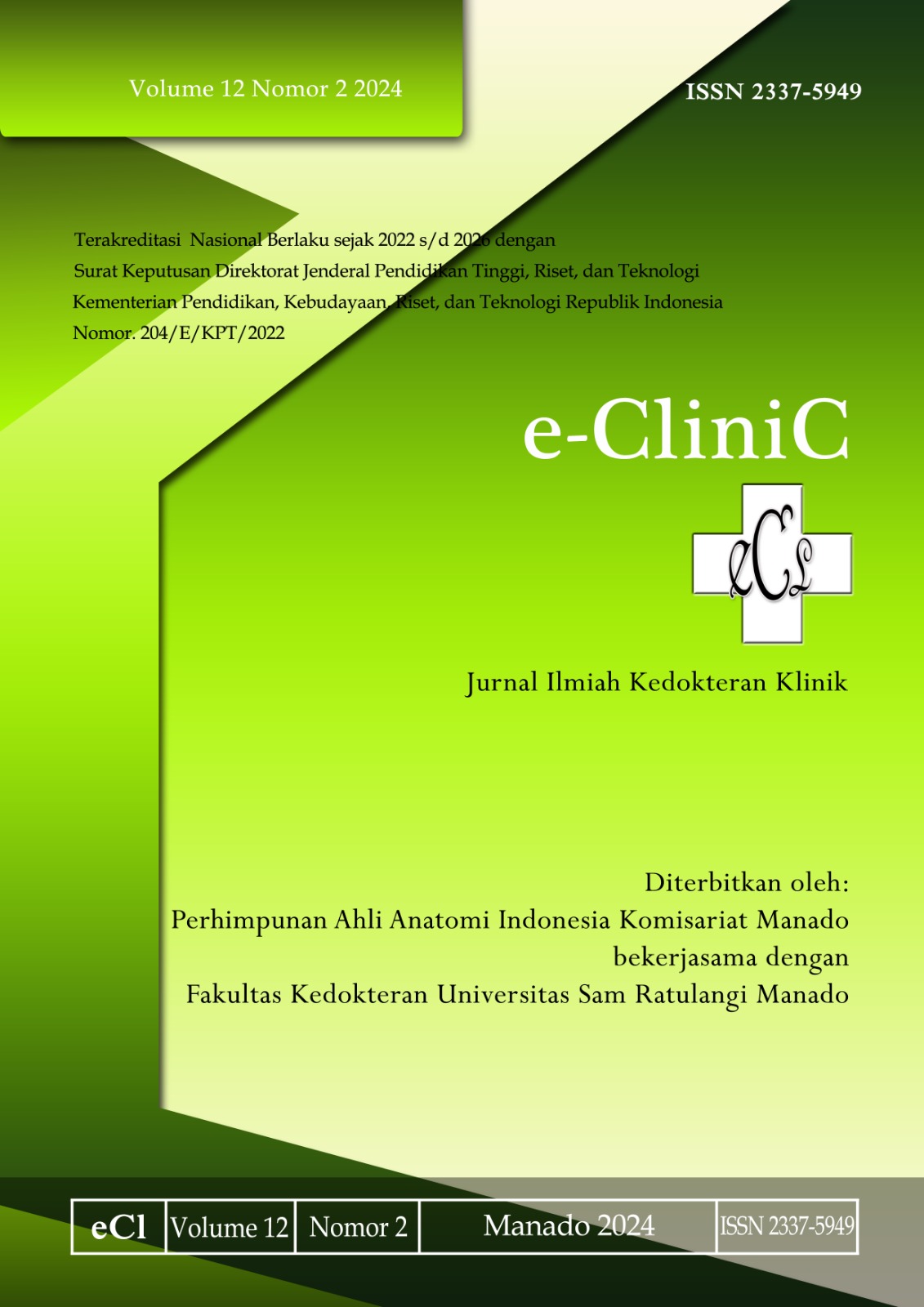Rehabilitation for Marfan Syndrome
DOI:
https://doi.org/10.35790/ecl.v12i2.54474Abstract
Abstract: Marfan syndrome is a spectrum of disorders caused by a heritable genetic defect of connective tissue that has an autosomal dominant mode of transmission. The defect itself has been isolated to the FBN1 gene on chromosome 15, which codes for the connective tissue protein fibrillin. Abnormalities in this protein cause a myriad of distinct clinical problems, of which the musculoskeletal, cardiac, and ocular system problems predominate. The skeleton of patients with Marfan syndrome typically displays multiple deformities. Mitral valve prolapses that requires valve replacement can occur as well. Given the variable expressivity of Marfan Syndrome, no single sign is pathognomonic; the diagnosis is made on clinical grounds on the basis of typical abnormalities. We reported a boy, 12 years old, referred from surgeon with diagnosis pectus carinatum pro brace. Chest protusion appeared since age 6, getting bigger without any complaint but cosmetic. Other complaints on feet which looked flat, sometimes ankle sore after long distance running or futsal. He was the first child and no family history had a condition like him. His hobby was playing futsal, and daily activities were independent without assistive devices. General appearance and vital signs were normal, cardiorespiratory assessment was normal, BMI on percentile 10-25, arm span to height ratio 1.09, lens subluxation of left eye, lens dislocation of right eye, poor standing balance, inadequate toe off, thoracic hyperkyphotic, positive wrist sign, true leg length discrepancy of 1 cm (left>right), bilateral ankle ROM limitation, rigid flat feet suspected bilateral vertical talus, left hallux valgus, Marfan syndrome score 9, and normal echocardiography. In this patient, we gave semi rigid thoraco-lumbo-sacral orthosis (TLSO) with 3 points pressure system and rigid bar on protution area (custom molded). resistance exercise (F: 3x/week, I: moderate fatigue, Borg scale 13-15/20, T: 8-15 reps/ set, 2-3 set/ session, T: major muscle group upper and lower extremities aerobic exercise (F: 3x/week, I: moderate to vigorous, borg scale 13-15/20, T: ≥60 min/session, @5-10 min warming up and cooling down (stretching), T: sport (swimming, running, cycling). The patient was referred to a surgeon for a brace. In conclusion, this case report highlights the multidisciplinary management of patients with Marfan syndrome.
Keywords: Marfan syndrome; typical abnormalities; multiple deformities
References
Pollock L, Ridout A, Teh J, Nnadi C, Stavroulias D, Pitcher A, et al. The musculoskeletal manifestations of marfan syndrome: diagnosis, impact, and management. Curr Rheumatol Rep. 2021;23(11):1-8. Doi: 10.1007/s11926-021-01045-3
Dietz H. FBN1-related Marfan syndrome. Gene Reviews (R). Adam MP, Ardinger HH, Pagon RA, Wallace SE, editors. Seattle: University of Washington; 2022.
Bitterman AD, Sponseller PD. Marfan syndrome: a clinical update. Journal of the American Academy of Orthopaedic Surgeons (JAAOS). 2017;25(9):603-9. Doi: 10.5435/JAAOS-D-16-00143
Fraser S, Child A, Hunt I. Pectus updates and special considerations in Marfan syndrome. Pediatr Rep. 2018;9(4):7277. Doi: 10.4081/pr.2017.7227
Chiu HH. An update of medical care in Marfan syndrome. Tzu-Chi Medical Journal. 2022;34(1):44-8. Doi: 10.4103/tcmj.tcmj_95_20
The Scottish National Chest Wall Service. Chest wall bracing for children and young people with pectus carinatum. 2022. Available from: https://chestwallservice.scot.nhs.uk
Cheek T. Pectus Carinatum: Pigeon Chest. The Surgical Technologist. 2010:495- 507. Available from: https://www.ast.org/articles/2010/2010-11-323.pdf
Kravarusic D, Dicken BJ, Dewar R, Harder J, Poncet P, Schneider M, et al. The Calgary protocol for bracing of pectus carinatum: a preliminary report. J Pediatr Surg. 2006;41(5):923-6. Doi: 10.1016/j.jpedsurg.2006.01.058
American Pediatric Surgical Association. Pectus carinatum guideline. Am Pediatr Surg Assoc. 2012;16. Available from: https://apsapedsurg.org/wp-content/uploads/2020/10/Pectus_CarinatumGuideline _080812.pdf
Arachchige SNK, Chander H, Knight A. Flatfeet: biomechanical implications, assessment and management. The Foot. 2019;38:81-5. Doi: 10.1016/j.foot.2019.02.004
Turner C, Gardiner MD, Midgley A, Stefanis A. A guide to the management of paediatric pes planus. Australian Journal of General Practice (AJGP). 2020;49(5):245-9. Doi: 10.31128/AJGP-09-19-5089
Carr JB, Yang S, Lather LA. Pediatric pes planus: a state-of-the-art review. Pediatrics. 2016;137(3): e20151230. Doi: 10.1542/peds.2015-1230
De Maio F, Fichera A, De Luna V, Mancini F, Caterini R. Orthopaedic aspects of Marfan syndrome: the experience of a referral center for diagnosis of rare diseases. Adv Orthop. 2016; 2016: 8275391. Doi: 10.1155/2016/8275391
Miller M, Dobbs MB. Congenital vertical talus: etiology and management. zournal of the American Academy of Orthopaedic Surgeons (JAAOS). 2015;23(10):604-11. Doi: 10.5435/JAAOS-D-14-00034
Mckie J, Radomisli T. Congenital vertical talus: a review. Clinics in podiatric medicine and surgery. 2010;27(1):145-56. Doi: 10.1016/j.cpm.2009.08.008
Downloads
Published
How to Cite
Issue
Section
License
Copyright (c) 2024 Christi E. Hartanto, Gloria E . Rondonuwu, Joudy Gessal

This work is licensed under a Creative Commons Attribution-NonCommercial 4.0 International License.
COPYRIGHT
Authors who publish with this journal agree to the following terms:
Authors hold their copyright and grant this journal the privilege of first publication, with the work simultaneously licensed under a Creative Commons Attribution License that permits others to impart the work with an acknowledgment of the work's origin and initial publication by this journal.
Authors can enter into separate or additional contractual arrangements for the non-exclusive distribution of the journal's published version of the work (for example, post it to an institutional repository or publish it in a book), with an acknowledgment of its underlying publication in this journal.
Authors are permitted and encouraged to post their work online (for example, in institutional repositories or on their website) as it can lead to productive exchanges, as well as earlier and greater citation of the published work (See The Effect of Open Access).







